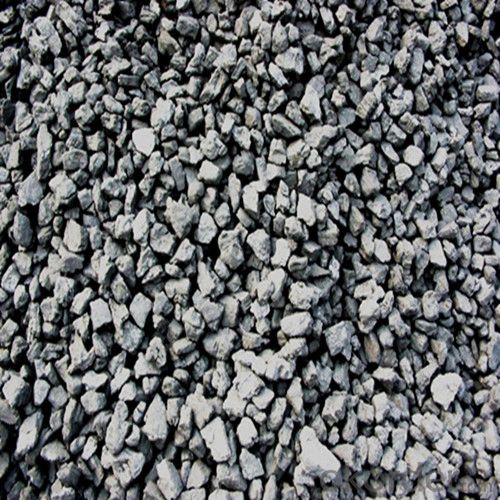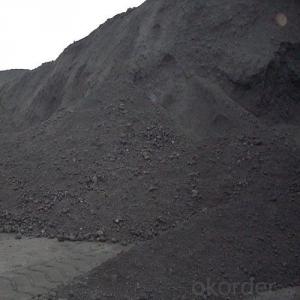Metallurgical Coke of Coke Strength after Reactivity 64
- Loading Port:
- Tianjin
- Payment Terms:
- TT OR LC
- Min Order Qty:
- 100 m.t.
- Supply Capability:
- 3000 m.t./month
OKorder Service Pledge
OKorder Financial Service
You Might Also Like
1. Structure of Metallurgical Coke of Coke Strength after Reactivity 64 Description:
Coke is a hard texture, with carbon as the main component of irregular porous body, with cracks and defects in silver. The true density is 1.8 ~ 1.95 g/cm3, bulk density is 400 ~ 500 kg/m3, the porosity of 35% ~ 35%,.Coke all vertical and horizontal crack can be seen with the naked eye observation. The vertical and horizontal crack along the thick break, still is focal piece containing micro cracks. Separate focal piece of micro cracks along, namely coke porous body, also known as coke. Focal body consists of porosity and the pore wall, hole wall is also called the coke quality, its main component is carbon and minerals. How much coke crack directly affect the size and crushing strength of coke. Focal piece of micro cracks and holes spore structure of coke and abrasive resistance and high temperature reaction performance of coke has a close relationship. Spore structure usually use stomata average pore size and pore size distribution, specific surface area and pore wall thickness parameter.
2. Main Features of the Metallurgical Coke of Coke Strength after Reactivity 64:
• Quality assurance
• Mutual benefit
• Preferential price
3. Metallurgical Coke of Coke Strength after Reactivity 64 Images:




4. Metallurgical Coke of Coke Strength after Reactivity 64 Specification:
Parameters | Guarantee | Rejection |
Total Moisture (As received basis) | 5% max | |
Ash (dry basis) | 12.5% max | > 13.5% |
Volatile Matter (dry basis) | 1.5% max | > 1.8% |
Sulphur (dry basis) | 0.65% max | > 0.75% |
Phosphorus (dry basis) | 0.035% max | > 0.045% |
M10 | 7% max | > 9% |
M40 | 84% min | <82% |
CSR | 64% min | <62% |
CRI | 26% max | > 28% |
Size 30-90 mm | 90% min | |
+90 mm | 5% max | > 8% |
-30mm | 5% max | > 8% |
5. FAQ
We have organized several common questions for our clients,may help you sincerely:
1) How about your company?
Our company began to export coke when China cancelled 40% of coke export tariffs and quotas on January 1, 2013. We export many kinds of coke, such as CSR60 % and CSR 62% metallurgical coke (met coke), the NUT coke of 20 to 50 mm, coke breeze of 3 to 6 mm, and so on.
2) Application of coke
• Used for blast furnace ironmaking and used for copper, lead, zinc, titanium, antimony, mercury
• Other non-ferrous metal smelting of blast furnace,
• Reducing agent, compound
• The function of stock column frame.
3) The history of coke
Our country's metallurgical industry has a long history, is the original fuel charcoal smelting industry, due to the charcoal burning temperature is lower, and short duration of fire and not easy to master hour, therefore, directly affect the level of smelting, to make the steel quality is not guaranteed. Later, people use coal as smelting, coal combustion temperature is higher, and the combustion duration is longer than charcoal, but easily broken after coal is heated in the oven, affect the burden of permeability, and high content of sulfur in coal, directly affect the quality of the cast iron. After a period of practice, it has been found that the coal after dry distillation (i.e., separated flame heating), volatile components may be removed, and the porosity increased, resembling charcoal, fire is better than that of coal, but also can avoid charcoal and coal. This after carbonization of coal is coke.
- Q: What is the density of coke?
- The true density of coke: 1.8 ~ 1.95kg/cm3; apparent density: 0.8 ~ 1.08kg/cm3; pile density: 400 ~ 500kg/cm3
- Q: Coke belongs to the coal industry
- 11 other mining industry 28 chemical fiber manufacturing 58 warehousing industryC manufacturing 29 rubber products 59 postal industry13 agricultural and sideline products processing industry 30 plastic products G information transmission, computer services and software industry31 grain grinding of non metallic products 60 telecommunications and other information transmission services 13101320 feed 311 cement, lime and gypsum manufacturing 601 Telecommunications133 vegetable oil 312 cement and gypsum products manufacturing 6020 Internet information1340 sugar 313 brick, stone and other building materials 603 broadcast television transmission135 slaughter and meat 314 glass and glass products 604 satellite transmission136 aquatic products 315 ceramic products 61 computer services
- Q: Coking coal, coke, coal, steam coal what is the difference?
- Coking coal is the raw material for coke
- Q: What are the main uses of coke
- Main use of coke:1, is the most important coking products, more than 90% countries most coke used in blast furnace, blast furnace with coke instead of charcoal, laid the foundation for the large-scale modern blast, is an important milepost in the history of metallurgy.
- Q: What is the difference between coking plant and coke plant
- Never heard of coke plant, coking plant is the production of coke products, there are other chemical products, it is estimated that you said the coke plant is the purchase of other people's desire to sell second-hand coke traders.
- Q: China's coke iron smelting began in what time?
- The ancient iron smelting method in smelting iron block, lower temperature, iron ore solid reduction sponge iron, and iron into play by forging. Smelting iron block, furnace, furnace with ground and shaft 3. The block iron making in our country began in the spring and Autumn period, and in the near future, the pig iron with more than 2% carbon dioxide was refined and used as a casting tool
- Q: How much coke can a ton of coal
- But before the words to use 1.5 tons of coking coal to produce a total of 1 tons of coke
- Q: What is the amount of waste gas produced by a ton of coke burning
- The coking coal is heated to 1000 DEG C under the condition of isolated air (high temperature carbonization)
- Q: What are the requirements for coke and other accounts?
- Coke futures margin is about 10% or so is quoted at $1169 per ton, trading units of 100 tons per hand, so do a coke about $11690.
- Q: I work in the coking plant, so there are conditions to get coke and is burning, I would like to use coke barbecue line? Just like charcoal Mutton Cubes Roasted on a Skewer, OK? Understand the answer
- I work in the coking plant, so there are conditions to get coke and is burning, I would like to use coke barbecue line? Just like charcoal Mutton Cubes Roasted on a Skewer, OK? Understand the answer
Send your message to us
Metallurgical Coke of Coke Strength after Reactivity 64
- Loading Port:
- Tianjin
- Payment Terms:
- TT OR LC
- Min Order Qty:
- 100 m.t.
- Supply Capability:
- 3000 m.t./month
OKorder Service Pledge
OKorder Financial Service
Similar products
Hot products
Hot Searches






























